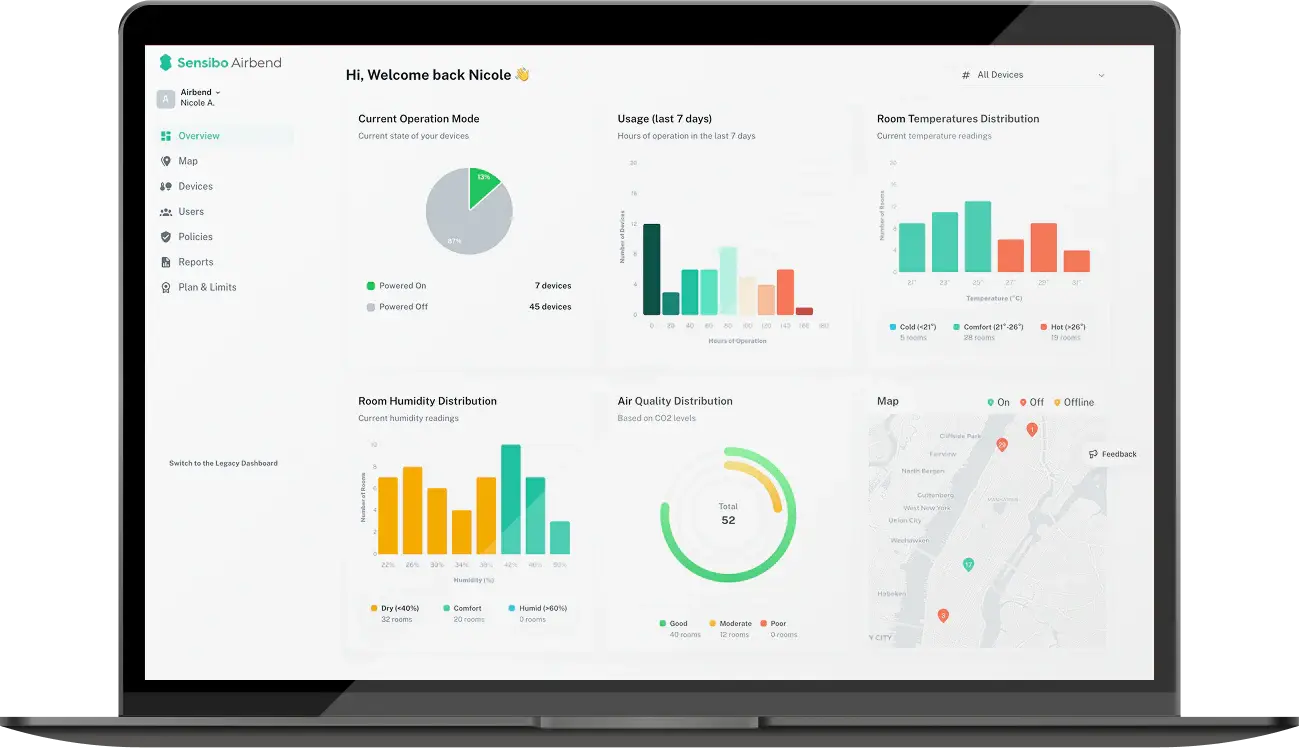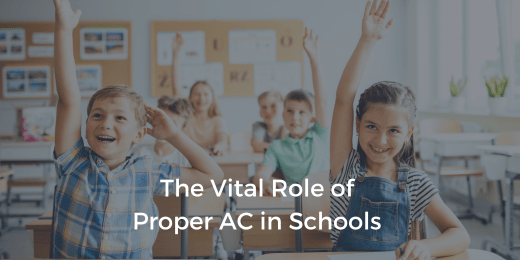The Vital Role of Air Conditioning in Schools for Optimal Classroom Learning
Key Takeaways
- Students perform 18% better on tests when classrooms maintain 68-74°F, but poor climate control affects 41% of U.S. school districts
- Harvard research tracking millions of students reveals the shocking connection between graduation rates and test-day temperatures
- Air conditioning in schools costs less than $2 per student annually but delivers over $25,000 in lifetime learning benefits per classroom
- Health conditions require proper ventilation – asthma, allergies, and respiratory issues each improve with quality classroom air conditioner systems
- Educational equity depends on climate access – disadvantaged schools face a double burden that smart solutions can address
How often should your school's air conditioning run for optimal learning? For peak educational outcomes, experts recommend continuous operation during school hours. The real answer depends on your specific building, student needs, and budget considerations.
Every classroom faces the same challenge: creating an environment where young minds can thrive. While curriculum and teaching quality rightfully get attention, there's an invisible factor that impacts student success – classroom air conditioning performance and indoor climate quality.
Why Classroom Temperature Directly Affects Student Learning
Your students' brains are working overtime – but not on the lessons you're teaching. When classroom temperatures climb above 75°F or drop below 68°F, their minds shift focus from learning to thermal regulation. This biological response directly impacts academic performance.
Harvard research tracking 10 million students found that each 1°F increase in average school year temperature correlates with a 1% decline in learning. However, schools with proper air conditioning showed virtually no negative learning effects from heat exposure.
How Temperature Affects Student Performance
Students experience real cognitive changes when classrooms become too hot or cold. Here's what happens inside their brains:
- Memory Formation Suffers: Research from Loyola University found that memory performance drops significantly in both 80°F and 64°F environments. Peak cognitive function occurred at 72°F – right in the range your classroom cooling system should maintain.
- Attention Spans Shrink: When the body expends energy regulating temperature, less glucose remains available for higher-order thinking. Students literally cannot focus as well when fighting thermal discomfort.
- Test Scores Drop Measurably: New York students were 12% more likely to fail graduation exams when outdoor temperatures hit 90°F compared to 72°F. Schools without adequate school air conditioning saw the most impacts.
The Optimal Temperature Range for Learning
Research consistently points to 68-74°F (20-23°C) for optimal classroom performance. Here's what studies show happens at different temperatures:
- At 72°F: Students achieve 90% average test scores
- At 81°F: Performance drops to just 72% average
- At 61°F: Scores plateau around 76% average
 How Does Classroom Air Quality Affect Student Health?
How Does Classroom Air Quality Affect Student Health?
Asthma and Allergy Relief
Properly maintained classroom air conditioning systems filter airborne allergens, dust, and pollutants that trigger respiratory issues. The EPA ranks indoor air pollution among the top five environmental health risks, making classroom air quality a critical concern.
Reduced Sick Days
Schools with improved HVAC systems report 3-5% decreases in student absences. Better air circulation minimizes the spread of airborne illnesses, keeping students in class where they belong.
Cleaner Air for Everyone
Systems equipped with HEPA filtration remove 99.97% of particles as small as 0.3 microns. That includes bacteria, viruses, pollen, and pet dander that can make school days miserable for sensitive students.
Better Sleep Quality
Students without home air conditioning often experience poor sleep during hot weather. Schools with reliable classroom cooling systems provide consistent learning environments that don't compound sleep-related performance issues.
Reduced Stress Response
Thermal discomfort triggers stress hormones that interfere with learning and memory formation. Comfortable classrooms allow students' minds to focus on education, not survival responses.
Smart Air Conditioning For Schools
Schools need intelligent climate management to maximize both learning outcomes and energy efficiency. Traditional HVAC systems often operate inefficiently, wasting energy while failing to maintain optimal learning conditions. Smart air conditioning in schools provides precise control, energy savings, and improved educational outcomes through advanced technology integration.
Climate Control Benefits
Energy Efficiency and Cost Management:
- Automated scheduling reduces energy consumption by up to 30%
- Smart sensors adjust cooling based on occupancy and real-time conditions
- Predictive maintenance prevents costly system failures during peak seasons
- Real-time energy monitoring identifies optimization opportunities across multiple buildings
Enhanced Indoor Air Quality:
- Continuous monitoring of CO2, TVOC, and particulate matter levels
- Automatic ventilation adjustments based on air quality readings
- HEPA filtration integration for cleaner classroom environments
- Intelligent humidity control prevents mold growth and maintains comfort
Centralized Management Capabilities:
- Unified dashboard for monitoring multiple classrooms and buildings
- Bulk adjustments across entire districts from one interface
- Role-based user permissions for different staff responsibilities
- Remote troubleshooting and system diagnostics reduce maintenance costs
Advanced Automation Features:
- Integration with school schedules for optimal pre-cooling and energy savings
- Weather-responsive climate adjustments based on local conditions
- Motion detection for occupancy-based control in unused spaces
- Customizable policies for different areas (classrooms, gyms, libraries, cafeterias)
 Implementing Smart Solutions
Implementing Smart Solutions
Upgrade your existing systems without major renovations. Sensibo's Airbend platform for schools converts any remote-controlled classroom air conditioning unit into an intelligent, networked system without expensive retrofits or construction disruptions.
Simple Installation Process:
- Plug-and-play setup takes minutes per classroom
- No electrical work or construction required
- Compatible with any remote-controlled AC system
- Minimal disruption to daily school operations and teaching schedules
Intelligent Management Features:
- Create customized climate policies for different educational spaces
- Set automated schedules aligned with school calendars and bell schedules
- Monitor and control hundreds of units from one centralized interface
- Generate detailed energy usage and cost-saving reports for administrators
Real-Time Air Quality Monitoring:
- Track indoor air pollutants that affect student health and performance
- Automated alerts for poor air quality conditions requiring immediate attention
- Integration with air purification systems for comprehensive environmental control
- Historical data analysis for identifying trends and optimization opportunities
Should You Run School AC Systems All Day During Classes?
During school hours, absolutely. Student performance, health, and safety depend on consistent climate control throughout the academic day.
Pre-School Preparation (1-2 hours before arrival)
Smart systems automatically pre-cool classrooms before students arrive, ensuring optimal learning temperatures from the first bell while reducing energy costs by avoiding peak-demand cooling periods.
Continuous Operation During School Hours
Maintain a consistent 68-74°F range throughout the academic day. Systems adjust automatically based on occupancy and outdoor conditions, preventing afternoon heat buildup that affects final-period performance.
After-Hours Efficiency
Smart scheduling reduces operations when buildings are unoccupied while maintaining minimum ventilation for air quality without overcooling. Systems are prepared for next-day operation while minimizing energy waste.
During Testing Periods
Maintain stricter temperature control (68-72°F) during standardized testing to ensure optimal cognitive performance when it matters most.
Hot Weather Events
Increase operation frequency and intensity during heat waves. Some districts now use remote learning on extreme heat days, but proper school air conditioning systems eliminate this need.
Allergy Season Management
Boost filtration and ventilation during high pollen periods. Students with allergies show measurable improvement in climate-controlled environments.
After Construction or Renovation
Run systems continuously with enhanced filtration to clear dust, VOCs, and other construction-related pollutants that can affect student health.
How Does Poor Climate Control Create Educational Inequality?
Every student deserves a comfortable learning environment. Unfortunately, schools serving predominantly low-income and minority students are disproportionately likely to have inadequate air conditioning systems. This disparity reinforces educational inequities and limits learning opportunities where they're needed most.
The Equity Challenge
- Infrastructure Gaps: Research reveals that disadvantaged schools are more likely to have outdated, inadequate, or non-functional HVAC systems. Students in these schools face double challenges – economic disadvantages at home and suboptimal learning environments at school.
- Climate Change Intensifies Needs: Rising global temperatures make classroom air conditioning systems increasingly essential for maintaining educational continuity. Schools without proper climate control face more frequent heat-related closures and reduced instructional time.
- Federal Investment Opportunities: The estimated $72 billion needed to upgrade substandard school HVAC systems represents a significant but necessary investment in educational equity. Programs like ESSER funding and the Inflation Reduction Act provide unprecedented opportunities to address these gaps.
Implementation for Budget-Conscious Districts
Budget-conscious districts can start with phase implementation, beginning with high-priority spaces like testing rooms and special education classrooms where climate control has the most immediate impact on vulnerable student populations. Rather than a complete system replacement, districts can use intelligent controllers to optimize existing systems first. Many older classroom air conditioning units can be significantly improved with smart technology additions that provide substantial benefits at a fraction of replacement costs.
Schools can document energy savings from smart system upgrades to fund additional improvements over time. Many districts discover that efficiency gains pay for expanded climate control within 2-3 years, creating a self-funding cycle for continued upgrades.
 When Should Schools Prioritize AC Upgrades?
When Should Schools Prioritize AC Upgrades?
Start with data, not assumptions. Assess your current systems' performance before making upgrade decisions.
Assessment Priorities
Schools should install monitoring systems in representative classrooms to document actual temperature ranges throughout school days. Many administrators are surprised by the temperature variations their students experience during different periods and seasons. Professional energy audits can identify the most cost-effective improvement opportunities while ensuring compliance with current building codes and safety standards.
Comparing standardized test scores and attendance data between well-conditioned and poorly conditioned classrooms within the same district often provides compelling justification for climate investments. The correlation between comfortable environments and academic performance becomes clear when examined systematically.
Maintenance Best Practices
Regular filter changes, system inspections, and calibration ensure that classroom cooling systems continue operating efficiently throughout their service lives. Proper training on smart system operation helps staff maximize benefits while minimizing operational disruptions and maintenance calls. Preparing systems for peak demand periods through professional inspections and maintenance before summer and winter temperature extremes prevents costly breakdowns during critical times.
Your Students' Success Depends on Smart Climate Decisions
Schools prioritizing climate control see measurable improvements in student performance, attendance, and overall educational outcomes. As educational leaders plan for the future, classroom air conditioning systems must be recognized as essential infrastructure for 21st-century learning environments.
Your students spend over 1,000 hours annually in your classrooms. Don't let inadequate climate control limit their potential during these critical learning years. Explore how smart air conditioning for schools can enhance educational outcomes while reducing operational costs and supporting long-term academic success.
FAQ
How much temperature variation is acceptable in classrooms?
Aim for no more than 2-3°F variation from your target temperature. Quality classroom air conditioner systems with smart controls can maintain ±1°F accuracy, providing optimal learning conditions throughout the day.
What's the return on investment for school climate control improvements?
Harvard research shows that proper school air conditioning generates over $25,000 per classroom annually in future earnings through improved educational outcomes. Most smart system upgrades pay for themselves through energy savings within 2-4 years.
How do I justify climate control costs to budget-conscious school boards?
Present the data: 18% better test performance, 3-5% improved attendance, and long-term energy savings of 25-40%. Frame climate control as educational infrastructure, not luxury amenities.
Can existing AC systems be upgraded to smart controls?
Yes! Most existing classroom air conditioning units with remote controls can be upgraded using smart controllers. This approach provides advanced functionality without expensive equipment replacement.
What funding sources support school HVAC improvements?
Federal programs, including ESSER funding, the Inflation Reduction Act, and various state initiatives, provide substantial financial support. Many schools can reduce upgrade costs by 30-50% through these programs.
How quickly can smart AC systems be installed in schools?
Smart controllers for existing air conditioning in schools can be installed in minutes per unit without construction disruption. Complete school implementations typically require only days rather than weeks or months.
Do climate control improvements really affect standardized test scores?
Yes, research consistently shows measurable improvements. Students in optimal temperature environments (68-74°F) score 12-18% higher on standardized assessments compared to those in poorly conditioned classrooms.



































-min.jpg?height=200&name=photo-classroom%20(1)-min.jpg)
.jpg?height=200&name=2150104970%20(1).jpg)

.jpg?height=200&name=2148921409%20(1).jpg)


